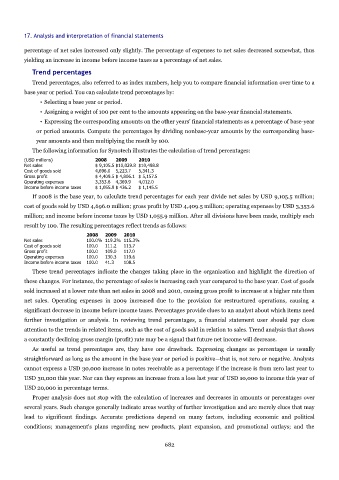Page 681 - Accounting Principles (A Business Perspective)
P. 681
17. Analysis and interpretation of financial statements
percentage of net sales increased only slightly. The percentage of expenses to net sales decreased somewhat, thus
yielding an increase in income before income taxes as a percentage of net sales.
Trend percentages
Trend percentages, also referred to as index numbers, help you to compare financial information over time to a
base year or period. You can calculate trend percentages by:
• Selecting a base year or period.
• Assigning a weight of 100 per cent to the amounts appearing on the base-year financial statements.
• Expressing the corresponding amounts on the other years' financial statements as a percentage of base-year
or period amounts. Compute the percentages by dividing nonbase-year amounts by the corresponding base-
year amounts and then multiplying the result by 100.
The following information for Synotech illustrates the calculation of trend percentages:
(USD millions) 2008 2009 2010
Net sales $ 9,105.5 $10,029.8 $10,498.8
Cost of goods sold 4,696.0 5,223.7 5,341.3
Gross profit $ 4,409.5 $ 4,806.1 $ 5,157.5
Operating expenses 3,353.6 4,369.9 4,012.0
Income before income taxes $ 1,055.9 $ 436.2 $ 1,145.5
If 2008 is the base year, to calculate trend percentages for each year divide net sales by USD 9,105.5 million;
cost of goods sold by USD 4,696.0 million; gross profit by USD 4,409.5 million; operating expenses by USD 3,353.6
million; and income before income taxes by USD 1,055.9 million. After all divisions have been made, multiply each
result by 100. The resulting percentages reflect trends as follows:
2008 2009 2010
Net sales 100.0% 119.2% 115.3%
Cost of goods sold 100.0 111.2 113.7
Gross profit 100.0 109.0 117.0
Operating expenses 100.0 130.3 119.6
Income before income taxes 100.0 41.3 108.5
These trend percentages indicate the changes taking place in the organization and highlight the direction of
these changes. For instance, the percentage of sales is increasing each year compared to the base year. Cost of goods
sold increased at a lower rate than net sales in 2008 and 2010, causing gross profit to increase at a higher rate than
net sales. Operating expenses in 2009 increased due to the provision for restructured operations, causing a
significant decrease in income before income taxes. Percentages provide clues to an analyst about which items need
further investigation or analysis. In reviewing trend percentages, a financial statement user should pay close
attention to the trends in related items, such as the cost of goods sold in relation to sales. Trend analysis that shows
a constantly declining gross margin (profit) rate may be a signal that future net income will decrease.
As useful as trend percentages are, they have one drawback. Expressing changes as percentages is usually
straightforward as long as the amount in the base year or period is positive—that is, not zero or negative. Analysts
cannot express a USD 30,000 increase in notes receivable as a percentage if the increase is from zero last year to
USD 30,000 this year. Nor can they express an increase from a loss last year of USD 10,000 to income this year of
USD 20,000 in percentage terms.
Proper analysis does not stop with the calculation of increases and decreases in amounts or percentages over
several years. Such changes generally indicate areas worthy of further investigation and are merely clues that may
lead to significant findings. Accurate predictions depend on many factors, including economic and political
conditions; management's plans regarding new products, plant expansion, and promotional outlays; and the
682

